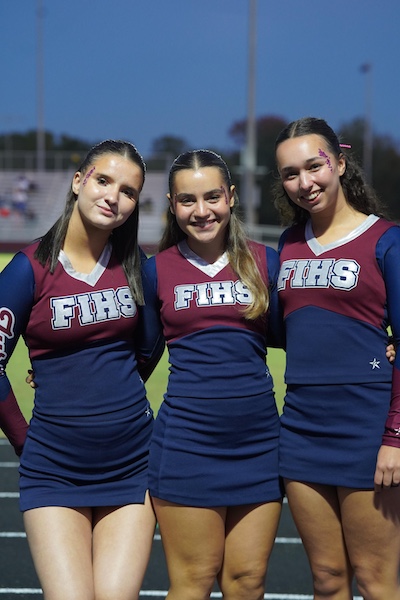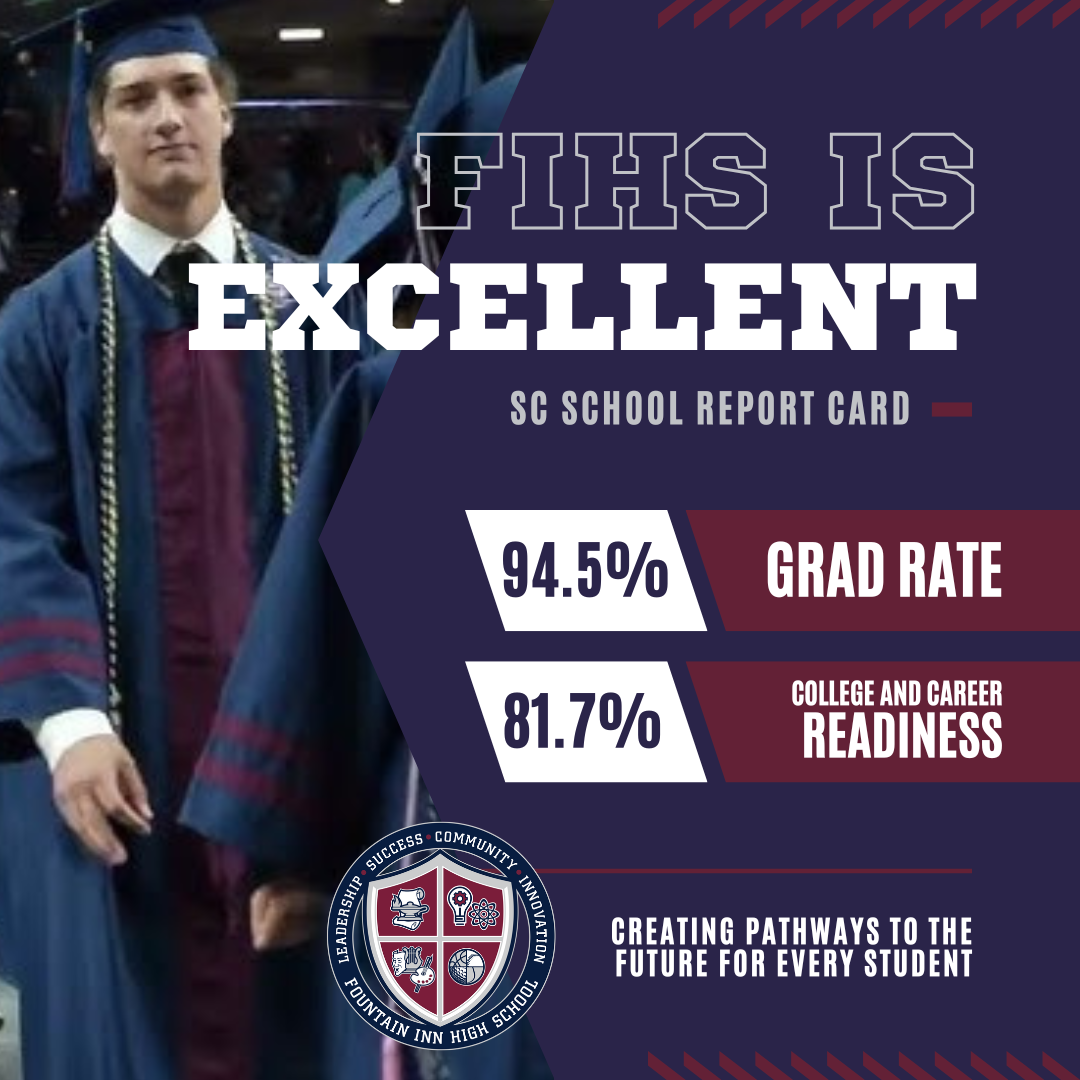


A New Home Away From Home
Five New Exchange Students at Fountain Inn
By Isabella Castro
In August, five new students joined us at Fountain Inn High School. They’re not just ordinary students, but special visitors from every corner of the world. Each student brought their own culture, background, experience, and personality. We have four kids from Europe; including juniors Elena Bausch from Hamburg, Germany; Laura Mazzini from Milan, Italy ; Laura Yloenen from Jyväskylä, Finland; and sophomore Alvaro Arderius Acha from Madrid, Spain. We also have junior Nicolas Montossa from São Paulo, Brazil. Although traveling over thousands of miles, these students did not let the distance get in their ways. They have made the most of their program and are bringing back so many memories when they go back home. Every single one of them are grateful for this experience and reflected on their journey navigating a new school in a new country.

For many of these students, it was their very first time stepping foot in the United States. While it was always a dream vacation spot, some had just never had the opportunity to open their horizons to visiting a new culture. There are many reasons why studying abroad is a beneficial chance for students. While some signed up to perfect their English, study a new culture, and achieve a sense of independence, others came to fulfill a life-long dream seen in movies: Teenage Life in America. As portrayed in movies such as High School Musical, Clueless and Devil Wears Prada; and shows such as Gossip Girl, Gilmore Girls, and Pretty Little Liars, these films all romanticize being a teenager in America.
“I always saw American movies and I just grew up thinking ‘oh I want to go to America’. I also wanted to experience the culture, how they live up here, and what the difference was between Germany and America. I've also always wanted to do it because I have friends my age in New York and I wanted to experience the same things as them,” said junior Elena Bausch.
As expected, there were major cultural differences that shocked these students. One common one was the kindness and familiarity shown to these students. Many were shocked at how friendly people were at the supermarket or the greetings that come when passing by someone. While in America people are friendly, they’re not drawn to give people a hug or kisses on the cheek when you meet someone you know. In Hispanic/Latin culture, it's a common standard to greet someone with two kisses on the cheek. For Alvaro Arderius Acha and Nicolas Montossa, this was an awkward shock to process. Although it was weird to adjust to, these challenges slowly turned into funny memories that remind them why they came in the first place.
“When I said hi to someone for the first time it was really weird. In Spain, if it's a woman you give two kisses on the cheek and if it's a guy you do a handshake. But here it's really different because when I arrived from the plane I gave my host mom two kisses on the cheek and she was shocked,” said Arderius.
The education system is very different across the world. Each and every student was awed at the massive school in front of them. Although they believe the rules are severe, the programs and opportunities within the school outweigh the disadvantages of strict bans and short time allotted for class changes. While the education system is different, some American students are still uneducated when it comes to thinking about culture outside the country. Some people have no sense of geography for countries around them or are ethnocentric about America. Another stereotype that was proven true was about the consumption of fast food. Other cultures believe that in the U.S., the majority of people would prefer fast food rather than home-cooked meals, which shocked a few of the exchange students.
“Another [stereotype] is that people don't know that much about other countries—where it is or what's going on outside the USA. I think it's true because some people don’t know and think Europe is a country. Others have thought that Finland is in Asia… [it’s not],” said junior Laura Yloenen.
But through all those unpleasantness, each student was able to find an extracurricular activity that they are passionate about. With Mazzini, Yloenen, and Bausch all in cheer, Arderius in Cross-Country, and Montossa working in music, all five students were able to surpass their knowledge and love for their sports. Every school in each country is different—some have more classes per day, others have longer breaks, or even smaller classrooms. The opportunity provided during secondary school allows for students to experiment taking courses that relate to their dream pathway. Students wanting to explore one certain pathway, can take classes relating to it, helping them decide whether it's truly something they want to work on.
“If you're interested in the medical field, like I am, in Italy you don't have this opportunity. You can only study medical things only at college or university. So if you end up not liking it at college, you have to lose one year of college, because you started the wrong one. So I love that here, you can choose your subject,” said Mazzini.
Moving to a new country was a giant step that each student took. They pushed themselves out of their comfort zones and learned how to be okay with being alone. The time difference between each student and their families doesn't allow for them to easily be able to speak with each other. For every person, leaving their family is difficult. Going from having your family and friends easily accessible to being halfway around the world by yourself is a hard and unthinkable concept. They were unable to get the support from the people they had always talked to. Luckily, for these students they found their own support system with their new host families and all their new friends.
“But when you are here at the beginning, you feel very, very alone, like lonely. Because you don't have friends, you don't have anyone. But now that I'm here, it's been two months and I have a lot of friends now,” said junior Laura Mazzini.
It not only has changed their views on the U.S., but also their views on themselves; their independence and confidence have improved as well. They have learned how to actually handle being alone and doing things alone, without help from their loved ones, especially when it comes to using a washing machine. We get so much help from our support systems that little tasks, such as washing clothes, go unnoticed until one realizes they don't know how to do it. Living abroad has changed their lifestyle and routine a lot, even their views on familiarity and meeting new people have changed.
“My independence has grown a lot actually. I’ve always just done something with someone, everything, like since I was kid. And being here, the first week and the first days, I had to do everything alone, so I now know how to do it,” Montossa said.
From these experiences, our exchange students are taking back loads of memories, growth as a person, confidence, knowledge, and a new set of family and friends. For anyone thinking of following in these footsteps and wanting to go explore a new country, being an exchange student isn’t a bad idea at all. While the idea may seem intimidating at first, the benefits outweigh it by far.

“Be open minded and always don't be shy and try to join as many clubs as possible as you can, do sports. If you also have a bad day, just remember that the next day will be better. If something goes wrong, it’s okay,” Mazzini said.
While many could see themselves back here, whether visiting or living permanently, each student valued their time here. Sadly, juniors Mazzini, Yloenen, Montossa are leaving after winter break. But Bausch and Arderius are staying until the end of this school year. Although it may not be the same, these students officially have found their own second home.
INN Our Eyes - Podcast Ep. 5
Foreign Exchange Students at FIHS
Bridges to a Better Future Pathway

Fountain Inn High School Report Card

Check out our new digital news source, THE FURY FLYER, which is run by our Journalism program.

MARK YOUR CALENDARS!!!
The Class of 2026 will hold their Graduation Ceremony at Bon Secours Wellness Arena on Friday, May 22nd, 2026 at 2:30 pm
Archive: Graduation Photos Class of 2025
2025-26 Instruction Dates - Sexual Health & Responsibility
Semester 1: Semester 1: September 29-October 8, 2025
Semester 2: Semester 2: February 20-March 4, 2026
Parent Preview
Parents may preview the lesson topics and general outline through the district website or they may come to the school and preview the lesson details and videos at any time during school hours.
Purchase tickets to Fury athletic events at GoFan